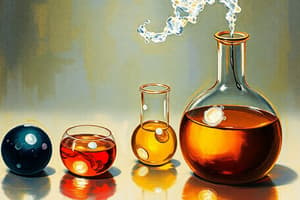Podcast
Questions and Answers
What type of solution contains the maximum amount of solute that can dissolve at a specific temperature and pressure?
What type of solution contains the maximum amount of solute that can dissolve at a specific temperature and pressure?
- Saturated solution (correct)
- Supersaturated solution
- Dilute solution
- Unsaturated solution
Which factor does NOT typically influence solubility?
Which factor does NOT typically influence solubility?
- Pressure
- Stirring
- Temperature
- Color (correct)
What type of solutions contain more solute than their saturation limit, but the excess solute is not in its molecular form?
What type of solutions contain more solute than their saturation limit, but the excess solute is not in its molecular form?
- Concentrated solutions
- Saturated solutions
- Supersaturated solutions (correct)
- Dilute solutions
In which type of gas-liquid solution is one component a gas and the other a liquid?
In which type of gas-liquid solution is one component a gas and the other a liquid?
What is the name of the thermodynamic quantity that describes the equilibrium between the solute and its ions in a solution?
What is the name of the thermodynamic quantity that describes the equilibrium between the solute and its ions in a solution?
Which industry relies on chemical solutions for processes like paint production and manufacturing?
Which industry relies on chemical solutions for processes like paint production and manufacturing?
What is a chemical solution?
What is a chemical solution?
Which statement about solutions is correct?
Which statement about solutions is correct?
In chemistry, which type of solutions do we primarily focus on?
In chemistry, which type of solutions do we primarily focus on?
What defines a binary solution?
What defines a binary solution?
What characterizes liquid-liquid solutions?
What characterizes liquid-liquid solutions?
Which classification of solutions includes ternary and quaternary solutions?
Which classification of solutions includes ternary and quaternary solutions?
Flashcards are hidden until you start studying
Study Notes
Chemical Solutions: A Fundamental Concept in Science
Chemical solutions are ubiquitous in our daily lives, yet they're often taken for granted. Understanding chemical solutions helps us grasp various scientific concepts and applications, from understanding our environment to producing medicines. Let's delve into this essential topic, starting with the basics.
Definition and Properties
A chemical solution is a homogeneous mixture of two or more substances, specifically a solute dissolved in a solvent. The solute is the substance that dissolves in the solvent and is typically present in lower concentration, while the solvent is the substance that dissolves the solute and is usually present in larger amounts.
Solutions can either be homogeneous (uniform throughout) or heterogeneous (not uniform). In chemistry, we focus on homogeneous solutions, which are generally transparent and isotropic, meaning they have the same properties in all directions.
Classification of Solutions
Solutions can be classified based on their composition:
- Binary solutions: These contain two components, a solute and solvent.
- Multiple solutions: These contain more than two components, such as ternary (three components) or quaternary (four components) solutions.
Solutions can also be classified based on their phase:
- Liquid-liquid solutions: Both the solute and solvent are liquids.
- Solid-liquid solutions: One of the components is a solid, while the other is a liquid. For example, a sugar solution.
- Gas-liquid solutions: One component is a gas, while the other is a liquid. For example, carbonated drinks.
Types of Solutions
Chemical solutions can be further categorized into the following types:
- Saturated solutions: A solution that contains the maximum amount of solute that can dissolve at a specific temperature and pressure.
- Supersaturated solutions: A solution that contains more solute than its saturation limit, but the excess solute is not in its molecular form.
- Unsaturated solutions: A solution that contains less solute than its saturation limit.
- Concentrated solutions: A solution that contains a high amount of solute compared to the solvent.
- Dilute solutions: A solution that contains a small amount of solute compared to the solvent.
Factors Affecting Solubility and Solubility Product
Solubility refers to the maximum amount of solute that can dissolve in a solvent at a specified temperature and pressure. Key factors affecting solubility include:
- Temperature: An increase in temperature typically results in an increase in solubility (except for some cases, such as solid-liquid solutions of gases or organic solvents).
- Pressure: An increase in pressure generally results in an increase in solubility in liquid-gas systems, but the effect on other systems is negligible.
- Stirring: Improving the rate of contact between a solute and solvent increases solubility.
- Solute-solvent interactions: The stronger the attractive forces between solute and solvent molecules, the lower the solubility.
Solubility product (Ksp) is a thermodynamic quantity that describes the equilibrium between the solute and its ions in solution. It is useful for predicting the solubility of sparingly soluble salts.
Applications of Chemical Solutions
The applications of chemical solutions are vast and can be found in almost every aspect of our lives:
- Medicines: Tablets, capsules, injections, and other drug preparations are often chemical solutions.
- Food and beverages: Carbonated drinks, fruit juices, soups, and sauces are all examples of chemical solutions.
- Cosmetics and personal care: Deodorants, toothpastes, and shampoos all contain chemical solutions.
- Industry: Chemical solutions are essential in various industries, including paint production, manufacturing, and cleaning.
Understanding chemical solutions is a fundamental concept in chemistry, enabling us to make sense of the world around us and apply that knowledge in numerous ways. From medicines to food and industry, the importance of chemical solutions is omnipresent.
Studying That Suits You
Use AI to generate personalized quizzes and flashcards to suit your learning preferences.




